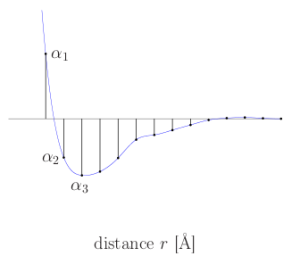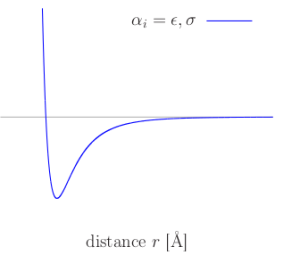This is an old revision of the document!
Potential models
potfit supports different ways of defining atomic interactions. All of them use a set of parameters $\alpha_i$ to define a potential function. Depending on the particular implementation these parameters have very different meanings.
Currently potfit supports the following models:
- Analytic potential functions
- KIM interactions
- Tabulated potential functions
Analytic potentials
Analytic potentials use the parameters $\alpha_i$ as arguments to analytic function templates. A well-known example for this would be the Lennard-Jones potential, which uses two parameters $\epsilon$ and $\sigma$ to define a potential.
Using an analytic form for $V(r)$ allows to define the atomic interaction for all possible distances between atoms with very few parameters compared to tabulated potentials. The problem of local parameters (see Tabulated potentials) is also not present, parameters are usually global parameters. In certain cases it is even possible to attribute some physical meaning to individual parameters.
The analytic potential implementation in potfit has additional features which are only useful with this kind of interactions. They are described on the analytic format page.
KIM interactions
#TODO
Tabulated potentials
Tabulated potentials are defined as a table of potential function values at discrete sampling points. potfit will interpolate between the sampling points to get potential values for all required interatomic distances.
While this may require more paremeters than the analytic variant it also allows for much greater flexibility in the potential function itself. While an analytic potential is bound to the parametric function and the resulting set of possible potential function, a tabulated potential can assume (almost) any discrete value at each sampling point.

A disadvantage of this type of potentials is the locality of the individual potential values. To provide a meaningful and transferable potential potfit requires reference data at all distances. If there is no reference data available for a certain distance, the potential value at this sampling point may assume a wide range of values without changing the target function at all. Such behavior is problematic for many optimization algorithms and needs to be watched closely while fitting a potential. Using the bindist option can be useful to check the distribution of available reference data with respect to the sampling points.

